|
a
- f | g - p | q - z
|
(The)
Geosophist's Tears, Peter Rose
2002, 8:00
A road movie of landscapes displaced, translated, and reconstructed
in perfect linear proportions and motions.
|
|
Gravel,
Steven Bognar

http://www.channel.creative-capital.org/project_9.html
Gravel, a short narrative shot on 16mm and Beta-SP video, weaves
several relationships in one story. A mother is attracted to an
ex-convict, and takes her teenage daughter on a road trip to meet
him. Ambivalent, the daughter brings along her skateboarder friend.
As the two weathered adults define their relationship, the memory
of the girl's dead grandmother hovers over the story. Gravel is
concerned with the capturing of photographs, and the importance
of images in the characters' lives. Told in an elliptical manner
that lets viewers assemble the events of the film, Gravel is set
against the haunted, impersonal quality of Midwestern Appalachia's
urban landscape.
|
|
Greetings
from Out Here, Ellen Spiro
1993, 58:00
http://www.utexas.edu/coc/rtf/faculty/spiro/films/greetings.html
Spiro
traveled for one year on the backroads of the southern United
States gathering footage for this mobile video project. Accompanied
by her dog Sam and a video camera, she travels from Virginia to
Texas and back. Her van (which breaks down frequently) serves
as office, apartment, editing suite, and runabout. From the many
insightful portraits of small town gay and lesbian Southerners,
to the celebratory events of the Texas Gay Rodeo, Rhythm Fest,
a gay Mardi Gras ball, and the Rural Fairy Gathering, Spiro’s
witty eye and spectacular footage capture the richness, vitality
and courage of “out” gay Southern life. Through her adventures,
she not only discovers strength in the many diverse gay and lesbian
people she gets to know, but also allows spontaneous encounters
with local eccentrics and mechanics to highlight her road documentary.
Courtesy
of Video Data Bank
|
|
High
School, Frederick Wiseman
1968, 75 min
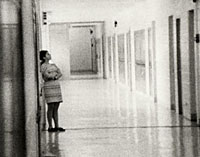
http://www.zipporah.com/
http://www.salon.com/people/conv/2002/01/30/wiseman/
http://www.walkerart.org/calendar/0311/details/Wiseman.html
"The
most frightening thing about High School is that it captures the
battlefield so clearly; the film is too true" (Newsweek). This
documentary shows us that a school system exists not only to pass
on facts but, ideally, to transmit social values from one generation
to another. In 1968 in a large school in Philadelphia, Wiseman
captures on film a series of formal and informal clashes between
teachers, students, parents, and administrators through which
the ideology and values of the school emerge. Spoofed in Wes Anderson's
1998 feature Rushmore, Wiseman's film is a wicked, brilliant documentary.
|
|
Highway
Landscape, J.J. Murphy
1971-1972, 16mm, color/so, 6.5m
"The
filmmaker describes his work as 'a single take, fixed camera meditation
on a dead rabbit on Highway No. 1, outside Iowa City.' As the
viewer stares at the almost still-life, the elements of composition
come together in sad juxtaposition; the silence of death is set
off against the impersonal whizz of passing cars, their momentary
appearance in the frame creating almost subliminal flashes of
bright metallic color. Otherwise the only movement in the film
is provided by the dead rabbit's fur, ruffling in the wind. In
the background, blue sky and brown trees, blurred and leafless.
In the foreground, hard white gravel. The rabbit's body, caught
in the right center of the frame, lies on the side of the highway,
which is reduced by the camera angle to an almost imperceptible
gray line dividing the composition in horizontal halves.
"I
think Murphy's description of HIGHWAY LANDSCAPE as a 'meditation'
is quite accurate, since minimal cinema allows the viewer to examine
in such radically increased attention the elements of the film
he is watching. Although the reality on the screen may be static,
the reality in the viewer's mind is not: under the right circumstances
(seldom possible in film-viewing situations), the viewer can 'contemplate'
what he sees, examines, let his eyes (and mind) wander, taste
the possibilities of response." - Ron Epple
http://commarts.wisc.edu/People/Bios/murphy.htm
|
|
Horizons,
Larry Gottheim
1973, 16mm, color/si, 80m
Completed in 1973 (with assistance from CAPS), HORIZONS was released
as an individual film and continues to stand as such. However,
I have incorporated it as Part 1 "Overture" to the series Elective
Affinities, which includes three further sound films: MOUCHES
VOLANTES (1976), FOUR SHADOWS (1978) and TREE OF KNOWLEDGE (1981).
For information on special rates for the entire series contact
Canyon Cinema.
"This
was also my fifth viewing of Gottheim's HORIZONS. (It is said,
in Analects, VII:31, that 'when Confucius was pleased with the
singing of someone he was with, he would always ask to have the
song repeated and would join in himself.') During the first viewing
of HORIZONS, in London, I just looked at it, with my eyes all
open and ablaze, and I found it very beautiful. Later I listened
to Gottheim talk about the film. I found out about the complex
web of image rhymes and correspondences in the film. During my
second and third viewings I became very absorbed in seeing and
figuring out the correspondences and rhymes. But I found the film
equally, if not more, beautiful. The fourth viewing was again
an open eye viewing, without any special emphasis. During the
Cooper Union screening I suddenly discovered its incredible richness
of color. I sat close to the screen and I saw these glorious colors
and I was amazed that I could look at HORIZONS four times and
not notice the magnificence of its color." - Jonas Mekas, Movie
Journal
Collection: Centre Beaubourg, Paris
|
|
Husks,
David Ellsworth
2002, 10:00, 16mm
New
barns. Old barns. Things that happen around corn. Agricultural
romantism and aesthetics in the Iowa lanscape.
http://www.uiowa.edu/~thaw/
|
|
HYBRID:
One Man's Passion for Corn, Monteith McCollum
2002, 92:00, b&w
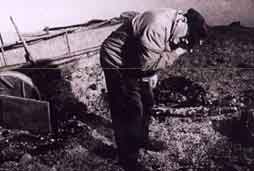
In
a rather unusual form, where animations of crawling and mating
corncobs alternate with meditative nature scenes, Hybrid tells
the story of one mans obsession for hybrid corn. Using dry Midwestern
wit, the film describes the sexuality of corn and delves deep
into one family's complex relationships with an eccentric man
who finds solace in the whispers of rustling cornfields. This
poetic opus says as much about the pragmatic spiritual values
and emotional inhibitions of the American hinterland as it does
about the archetypal Midwesterner, Milford Beeghly.
Beeghly had a passion for developing hybrid corn and appeared
on early black and white television, hawking his daring new seed
at a time when hybridization was considered a wicked kind of plant
incest. The film is in part a history of agricultural practices
during the depression and a science lesson, explaining how corn
procreates. "Hybrid" takes on a fuller resonance because of the
current fears about the harm that might be done by genetically
engineered crops.
McCollum began this major study of American farm-belt culture
(and it's loss) with an impetus to get to know his grandfather,
the man who remained an enigma to his family for most of his life.
The film was 7 years in the making and is far from the realm of
genteel biographical inquiry. It is a rigorously inventive work
that defies classification whose images challenge accepted associations
of light, sound and space. McCollum set out to understand what
drove his grandfather and in the process he made a tremendous
film that examines what work means to the soul: a topic that is
particularly American.
http://www.der.org/films/hybrid.html
Big
Sky Documentary Film Festival, Montana, 2004
Pare Lorentz prize, Pennsylvania Film Festival, 2002
IFP/Direct TV-Truer than Fiction Spirit Award, Los Angeles, CA
Fipresci Critics Award, International Documentary Film Festival,
Amsterdam
Grand Jury Award , Best Feature, Slamdance Film Festival, UT
Awards Nominee, Best Long Form Documentary, IDA Awards, Los Angeles,
CA
Best Feature Length Documentary, Nashville Indendent Film Festival,
TN
Best Documentary, South by Southwest International Film Festival,
Austin, TX
Golden Gate Certificate of Merit Awards, San Francisco International
Film Festival
Grand Jury Award, Best Film, Ann Arbor International Film Festival,
MI
|
|
If
You Lived Here, You'd Be Home By Now, Diane Bonder
2001, 15:00, 16mm

If
You Lived Hereis about the divisiveness over land, the relationship
of public and private space in small town America, and the concept
of home. Using documentary strategies, landscape stills are juxtaposed
to stories "ripped from the headlines" of a small-town
newspaper. The struggle over public space described in the stories,
reflect universal concepts of space, privacy and property ownership
everywhere.
http://www.uiowa.edu/~thaw/
|
|
If
You Lived Here, You'd Be Home By Now, Marina McDougall
1993, 12:00

http://www.hi-beam.net/mkr/mm/mm-bio.html
If
You Lived Here, You'd Be Home By Now mixes archival and original
footage to describe architectural, automotive and electronic realms
that have shaped the great American nomadic experience. From mobile
billboards to karaoke machines, this experimental documentary
essay combines images that evoke the ether of the American sprawl,
shaped by technologies which in overcoming time and space have
created a vast placelessness. The film takes on a wry, dispassionate
humor to cope with this human displacement.
|
|
ILLA
CAMERA OBSCVRA (The Dark Room), Thomas Comerford
2001, 12:00, 16mm, b&w
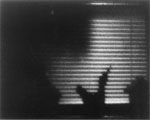
Latin
intertitles w/English translation. This pinhole film examines
the "camera obscura"--the "dark room"--as metaphor for cinema
and as site for shifts in perception and understanding perception.
Part of the "Cinema Obscura" series.
"
… a wonderful perceptual theory film in which theory becomes visible
and lyrical … It creates really elusive, wonderful images … a
brilliant film." --Jonathan Miller, 848, WBEZ (91.5) Chicago
http://home.earthlink.net/%7Etcomerfordil/film.html
|
|
In
Progress, J.J. Murphy (Co-maker: Ed Small)
1971-1972, 16mm, color/so, 18m
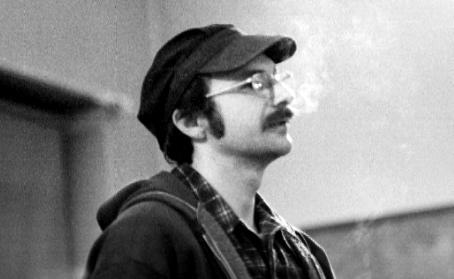
"All
the short movies that opened yesterday at the Film Forum make
some gesture toward elaborating concepts implicit in the nature
of film, concepts having to do with its existence in time and
the quality of its images .... J.J. Murphy's and Ed Small's IN
PROGRESS is the loveliest, most idiomatic, most responsible work
in the program. "IN PROGRESS is a 20-minute time-lapse movie recording
the passage of days and seasons from September through May on
a bit of landscape photographed on an Iowa farm. The camera doesn't
move (though there are two or three slightly different locations)
and it is so nearly passive that at one point frost is allowed
to form on its lens, and at another the dew turns its image into
a glamorous haze. IN PROGRESS really proves nothing except that
it has a subject worth sustained contemplation. The film provides
an access to such contemplation, and its beauty - including its
ravishing variations of color within the natural blues and greens,
grays, blacks, whites, and reddish browns - is in large part the
beauty of the subject in view." - Roger Greenspun, The New York
Times
Awards: Refocus, 1972; Independent Film-Makers' Competition, 1972;
Judge's Award, Bellevue Film Festival, 1973.
|
|
(An)
Injury To One, Travis Wilkerson
2003, 53:00, Color
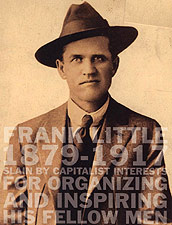
http://www.frif.com/new2003/inj.html
http://www.sundancechannel.com/docday/index.php?ixContent=5642
http://www.wsws.org/articles/2002/oct2002/wilk-o04_prn.shtml
AN
INJURY TO ONE provides a corrective - and absolutely compelling
- glimpse of a particularly volatile moment in early 20th century
American labor history: the rise and fall of Butte, Montana. Specifically,
it chronicles the mysterious death of Wobbly organizer Frank Little,
a story whose grisly details have taken on a legendary status
in the state. Much of the extant evidence is inscribed upon the
landscape of Butte and its surroundings. Thus, a connection is
drawn between the unsolved murder of Little, and the attempted
murder of the town itself.
Butte's
history was entirely shaped by its exploitation by the Anaconda
Mining Company, which, at the height of WWI, produced ten percent
of the world's copper from the town's depths. War profiteering
and the company's extreme indifference to the safety of its employees
(mortality rates in the mines were higher than in the trenches
of Europe) led to Little's arrival. "The agitator" found in the
desperate, agonized miners overwhelming support for his ideas,
which included the abolishment of the wage system and the establishment
of a socialist commonwealth.
In
August 1917, Little was abducted by still-unknown assailants who
hung him from a railroad bridge. Pinned to his chest was a note
that read 3'-7'-77", dimensions of a Montana grave. Eight thousand
people attended his funeral, the largest in Butte's history.
The
murder provides AN INJURY TO ONE with a taut, suspenseful narrative,
but it isn't the only story. Butte's history is bound with the
entire history of the American left, the rise of McCarthyism,
the destruction of the environment, and even the birth of the
detective novel. Former Pinkerton detective Dashiell Hammett was
rumored to have been involved in the murder, and later depicted
it in Red Harvest.
Archival
footage mixes with deftly deployed intertitles, while the lyrics
to traditional mining songs are accompanied by music from William
Oldham, Jim O'Rourke, and the band Low, producing an appropriately
moody, effulgent, and strangely out-of-time soundtrack. The result
is a unique film/video hybrid that combines painterly images,
incisive writing, and a bold graphic sensibility to produce an
articulate example of the aesthetic and political possibilities
offered by filmmaking in the digital age.
"An
astonishing document: part art and part speculative inquiry, buzzing
with ambition and dedication. Takes us from the 19th century to
the eve of the 21st, from Butte as land of frontier promise to
Butte as land of death and environmental destruction. He wields
avant-garde graphics and archival ephemera like a lasso, and his
shots of modern-day Butte are allusive still-lifes that defy time
and place. This is stirring, must-see stuff." - Austin Chronicle
"Wilkerson's
austere technique radically responds to the paucity of contemporaneous
documentary accounts, performing a powerful act of historical
archaeology and reclaiming for the working class its status as
subject, not a footnote, of historical events. Wilkerson makes
these ghostly historical agents palpable and vocal, asserting
the relevance of their story to struggles of today and tomorrow."
- Sundance Film Festival
|
|
Invisible
Hand: The Deindustrialization of Southern Illinois, Greg Boozell
2001, 29:00
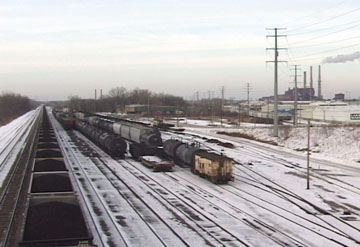
http://www.cantv.org/handtrib.htm
http://www.ucimc.org/newswire/display/1254/index.php
In
the early 1920's, there were over 100,000 coal mining jobs in
Illinois. Today only about 5,000 remain. While many may view coal
mining as an outdated 19th century enterprise, over 56% of U.S.
electricity is generated by burning coal today.
Economic and political factors, as well as environmental regulations
have contributed to the loss of the mining jobs in Illinois. Although
some have reduced this to a choice between jobs and clean air,
the actual conflict is more complex. In Illinois, the battle is
between electricity generating utilities on one side and coal
miners and environmentalists on the other.
The implementation of the Clean Air Act of 1990 contributed significantly
to the demise of Illinois coal mining. In order to comply with
the Act, Illinois power generating utilities needed to significantly
reduce the sulfur emissions of their power plants. To achieve
this, these corporations had several options: 1) install clean-coal
scrubber technology to remove pollutants; 2) decommission the
coal-fired plants and build new plants which would burn a more
environment friendly fuel like natural gas; or 3) substitute an
alternative lower-sulfur coal.
The latter was adopted by most Illinois power generating plants.
Lower sulfur coal is mined in the western U.S., primarily Wyoming
and Montana. Although burning western coal results in lower sulfur
emissions, scrubbed power plants are much cleaner. Scrubbed power
plants also make it possible to burn Illinois coal. "Our coalition
with the environmentalists seems strange," said Joseph Angleton,
President of District 12 of the United Mine Workers (UMWA). "But
we're trying to get legislation passed to lower sulfur standards.
By lowering sulfur standards you might be able to at least level
the playing field where you had to scrub coal no matter whether
it was western coal or whether it was Illinois coal. We think
if that takes place we'll take our chance in the market place."
Local environmentalists prefer the installation of clean coal
technologies to burning western coal. "Many of us believe the
coal plants are going to be with us a long time," said John Thompson,
Director of Clean Air Programs, Illinois Environmental Council.
"We are not going to be shutting them down in the near future
and therefore it makes sense to make them as clean as possible."
The shift to this western coal has been devastating for coal miners
in southern Illinois. It has meant the elimination of thousands
of mining jobs in the southern third of the state. Pres. Angleton
adds, "For every coal mining job lost, the Department of Labor
says there are four other jobs that are lost. When you look at
high paying jobs especially in rural areas in Southern Illinois,
it affects the school systems with the property tax. It affects
the people who own the car dealerships, the furniture stores,
it affects everything. The cumulative effect is really more than
anyone would ever dream."
Marissa is one southern Illinois town directly affected by the
loss of mining jobs. Incorporated in the late 19th century, Marissa
grew with the coal mining industry. Once the home of miners of
several area coal mines, the closing of the Marissa Mine in 2000
marked the end of coal mining in the immediate area. "These people
have pride but they also had a standard of living and uh, and
they can't keep that standard of living. That's just a fact. You
know, the jobs around here don't pay what the coal industry does,"
said Mayor Jerry Cross.
While EPA regulations are often portrayed as onerous and costly
to corporate America, current law exempts the oldest coal-fired
power plants from the EPA's most stringent air quality standards.
Because of EPA regulations, Illinois has fewer scrubbed power
plants than any other state in the U.S. John Thompson, Director
of Clean Air Programs, Illinois Environmental Council stated,
"What most people think is that the environmental regulations
that govern the operation of these plants really is designed to
protect the environment. It's true to an extent but what they
really do is protect the utilities. It gives them an enormous
license to pollute. They emit thousands of tons of pollutants
each year without having to install the kind of modern pollution
control equipment that you find not only in other states but is
widespread and common in Japan and Germany and Europe and in other
industrialized countries. We've simply chosen a path that grandfathers
these old plants and gives them a license to pollute."
Although there is a dearth of scrubbers on Illinois power plants,
ironically the state of Illinois has spent millions of tax dollars
developing clean coal technologies. While the technologies exist
to clean the air and protect Illinois mining jobs, Federal and
State officials have lacked the political will to require the
implementation of these innovations in Illinois.
Support from the government has taken the form of job retraining
programs for former coal miners. "Their answer is to come in and
give some money to retrain people to find a different job," said
Marissa Mayor Jerry Cross. "And that's good. Don't get me wrong.
You know that's good that they do that. But that's not the answer--these
people want their jobs. They want good paying jobs. They don't
want to be trained to have to leave the area."
Ty Becker President, President of UMWA Local 2412 adds, "They
are finding it very difficult now after losing their job for a
lot of them, 20, 25, 30, 35 years in the coal mines. Basically,
that's the only job that they have ever known. Its like they are
coming out of high school all over again and having to make a
decision on which way they are going to take their family to at
age 50, 55 years old. Too young to retire, uh, but really too
old to be employed at a very good job anywhere else."
"We
knew this clean air act was coming in 1990. And in the summer
of 2000 we begin to ask the question, how can we burn Illinois
air coal and keep clean air? You know, we waited way too long,"
said former miner, Lendell Moyers, "The technology is there. I'm
convinced of that. They are using it all over. I just don't understand
why we are not using it here."
"Invisible
Hand" recounts the decline of coal mining in Illinois and the
toll it has taken on the town of Marissa. Coal mining has been
a way of life in Marissa for decades and this video shows some
of the social effects resulting from the collapse of the coal
industry.
|
|
Is
the Crown at War With Us?, Alanis Obomsawin
2002, 96:00, 35mm
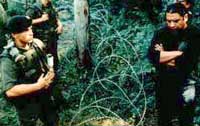
http://www.nfb.ca/crownatwar/
http://www.kingcanfilmfest.com/2003/films/crownwar.htm
http://www.sensesofcinema.com/contents/directors/02/obomsawin.html
Alanis
Obomsawin is the leading authority on documentaries that explore
the political and social struggles of Canada's Aboriginal people.
As one of Canada's most distinguished filmmakers, Obomsawin's
earlier works include Kanehsatake: 270 Years of Resistance, winner
of the top prize for a Canadian film at the 1993 Toronto International
Film Festival. Once again, in Is the Crown at War With Us?, Obomsawin
takes her small NFB crew to the heart of an Aboriginal community
in turmoil. She brings us the story of the Mi'gmaq fishermen from
Egenoopititj or Burnt Church, New Brunswick, who have been battling
with the Canadian government since the decision in 1993 to deny
them fishing rights. Although the Supreme Court reversed this
decision in 1999, the community erupted into violence in 2000
when the Federal Department of Fisheries and Oceans attacked Mi'gmaq
fishermen in their boats.
Obomsawin
weaves through the conflicting stories of the local and national
players, yet one cannot help but sympathize with the Mi'gmaq people.
Although this is a story of conflict and fierce emotions, Obomsawin
still finds the encouraging moments of camaraderie in a determined
community. As Obomsawin says, "It's important to show not
just the turmoil, but the beauty." This film is required
viewing for anyone who appreciates that Canada's future depends
on coming to terms with its past. - Stephanie Socol
|
|
Kanehsatake:
270 Years of Resistance, Alanis Obomsawin
1994, 120:00
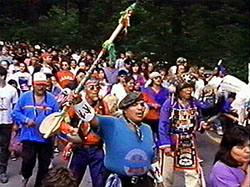
http://www.bullfrogfilms.com/catalog/153.html
http://www.cinematheque.bc.ca/JanFeb04/obomsawin.html
A
feature-length, multi-award winning documentary by Native American
filmmaker Alanis Obomsawin set in the thick of the armed confrontation
between Native American Mohawks and Canadian government forces
during the 1990 standoff in the Mohawk village of Kanehsatake
near the village of Oka in Quebec. The two-and-a-half month ordeal
received brief national attention when the Mohawk warriors of
Kahnawake, in support of their brothers from nearby Kanehsatake,
temporarily held the busy Mercier Bridge leading to Montreal,
in an effort to bring world attention to the situation.
Starting
with plans to construct a luxury housing development and expand
a private golf course into the Pines, part of Mohawk Nation's
land, tensions rose quickly and tempers flared as Mohawks were
once again fighting for their sovereignty. After a police officer
was killed in a raid to expel the Mohawks from the Pines, the
situation spiraled out of control. In scene after startling scene
the drama escalates as the Quebec police are replaced by units
from the Canadian army.
With
few exceptions journalists covering the crisis either evacuated
or were forcibly removed. Alanis Obomsawin spent the final weeks
of the standoff without a crew, shooting on video and using the
slow speed on her sound recorder to stretch out her limited supply
of audio tape.
Obomsawin's
detailed portrayal of the Mohawk community places the Oka crisis
within the larger context of Mohawk land rights dating back to
1535 when France claimed the site of present-day Montreal which
had been the Mohawk village of Hochelaga. Her evocative dimension
of the conflict, exploring the fierce conviction of the Mohawks
and the communal spirit that enabled them to stand firm.
Awards:
Distinguished Documentary Achievement, International Documentary
Association Awards, Los Angeles; Special Jury Award, San Francisco
International Film Festival; Best Canadian Feature Film, Festival
of Festivals, Toronto; Special Jury Award, Amiens International
Film Festival; Best Documentary Feature, American Indian Motion
Picture Awards; NFB Feature Documentary Award, Vancouver International
Film Festival; International Film Festivals: Sundance, Margaret
Mead, Leeds, Santa Barbara, Amsterdam Documentary, HongKong, Brisbane,
Hawaii, Melbourne, Montevideo, Haifa, Munich Documentary, London
Environmental, Seattle Human Rights, INPUT '94, Montreal, St.
John's Women's, Auckland, Wellington, Vermont
"The
film transports the viewer to the barricades and camps, achieving
a powerful immediacy and devastating logic. As each piece of her
story falls deftly into place, we begin to understand who was
fighting, and for what, and above all how it felt to be there.
Obomsawin avoids the pitfalls of romanticizing Mohawks and demonizing
whites..In short, Obomsawin has documented sympathetically yet
responsibly, and from a unique perspective what history may judge
to be the most significant event to take place on Canadian soil
since the Second World War." The (Toronto) Globe and Mail
|
|
La
Raison avant la passion, Joyce Wieland
1967-69, 82:00
"Joyce
Wieland's films are among the most endearing ever seen, making
her point and sealing the issue in a womanly way without any concern
for ragged edges. LA RAISON AVANT LA PASSION is a whirlwind view
of Canada with an anti-dialectical premise." - Douglas Pringle,
ArtsCanada
"REASON
OVER PASSION, then, is Joyce Wieland's major film so far. With
its many eccentricities, it is a glyph of her artistic personality;
a lyric vision tempered by an aggressive form and a visionary
patriotism mixed with ironic self parody. It is a film to be seen
many times." - P. Adams Sitney, Film Culture
"This
film is about the pain and joy of living in a very large space:
in fact, in a continent. It is painful, because such an experience
distends the mind, it seems too large for passionate reason to
contain. It is joyous, because 'true patriot love,' a reasonable
passion, can contain it, after all. But what is remarkable, for
me, is that all its urgency is lucidly caught, bound as it were
chemically, in the substance of film itself, requiring no exterior
argument." - Hollis Frampton
"Perhaps
Wieland's most ambitious project, an 80-minute feature film about
her homeland. As an artist, Wieland was deeply involved in the
creation of this particular film, a consideration of the positive
values inherent in Canadian society, as opposed to life within
the relatively repressive social fabric of the United States."
- program descriptions from "The Exploding Eye", Wheeler Winston
Dixon
http://www.nlc-bnc.ca/2/12/h12-523-e.html
|
|
La
Region Centrale, Michael Snow
1971, 16mm, color/so, 180m
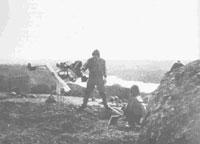
This
film is in five reels and requires two identical projectors for
continuous projection. Instructions are included for cueing from
reel to reel.
"This
new, three hour film by the Canadian Michael Snow is an extraordinary
cinematic monument. No physical action, not even the presence
of man, a fabulous game with nature and machine which puts into
question our perceptions, our mental habits, and in many respects
renders moribund existing cinema: the latest Fellini, Kubrick,
Buñuel etc. For LA REGION CENTRALE, Snow had a special camera
apparatus constructed by a technician in Montreal, an apparatus
capable of moving in all directions: horizontally, vertically,
laterally or in a spiral. The film is one continuous movement
across space, intercutting occasionally the X serving as a point
of reference and permitting one to take hold of stable reality.
Snow has chosen to film a deserted region, without the least trace
of human life, 100 miles to the north of Sept-Isles in the province
of Quebec: a sort of plateau without trees, opening onto a vast
circular prospect of the surrounding mountains.
"In
the first frames, the camera disengages itself slowly from the
ground in a circular movement. Progressively, the space fragments,
vision inverts in every sense, light everywhere dissolves appearance.
We become insensible accomplices to a sort of cosmic movement.
A sound track, rigorously synchronized, composed from the original
sound which programmed the camera, supplies a permanent counterpoint.
"Michael
Snow pushes toward the absurd the essential nature of this 'seventh'
art which is endlessly repeated as being above the visual. He
catapults us into the heart of a world before speech, before arbitrarily
composed meanings, even subject. He forces us to rethink not only
cinema, but our universe." - Louis Marcorelles, Le Monde
"Michael
Snow's LA REGION CENTRALE can be described as heroic bordering
on the apocalyptic. ... [I]t is an epochal film because of the
extent of the camera movements and its transformation of space
.... Gravity is destroyed ... the horizon line has been erased
and forgotten and the land mass has been transformed into a whirling
flat disc, a blurred flash of light with no mass or volume, rotating
wildly through the sky
.... Snow's mountain landscape has become a reflection on the
solar system." - Bill Simon, Artforum
"...
an unimaginable film, literally like nothing you have ever seen
before ...." - John W. Locke, Artforum
|
|
(The)
Learning Path, Loretta Todd
Native
control of education is explored in The Learning Path. Director
Todd, a Metis, introduces Edmonton elders Ann Anderson, Eva Cardinal,
and Olive Dickason, remarkable educators who are working with
younger natives. They recount harrowing experiences at reservation
schools, memories which fuelled their determination to preserve
their language and identities. Using a unique blend of documentary
footage, dramatic re-enactments, and archival film, Todd weaves
together the life stories of three unsung heroines who are making
education relevant in today's native communities.
http://www.frif.com/cat97/k-o/learning.html
http://www.frif.com/cat97/a-e/as_long_.html
http://www.nfb.ca/thepeoplegoon/
|
|
Lessons
of Darkness, Werner Herzog
1992, 52:00, 16mm

An
apocalyptic vision featuring the oilwell fires in Kuwait after
the Gulf-War, as a whole world burst into flames. This film is
stylized as science fiction, as there is not a single shot in
which you can recognize our planet.
http://www.wernerherzog.com/main/index_html.htm
|
|
Long
Journey Home, Elizabeth Barret
1987, 58:00
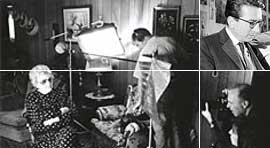
http://ns.appalshop.org/film/film.php?filmid=14
"Winter,
it wasn't so bad, but when it started getting spring, you'd start
looking out the factory doors, wanting to go home....We went about
oncet a month anyway. Load up on Friday night if I was working
days...and we'd cut out, throw the kids in the back, and drive
all night, with a case of beer, boloney, and cheese." -Bill
Belcher
"A
damn good film." -Studs Terkel, author
"Encountering
prejudice against 'hillbillies' and 'briars,' difficulties in
adjustment to the urban environment, the role of extended kin
in easing adjustment problems, and the contrasts in men's and
women's experiences are all touched on....provides excellent narration
on the history of Blacks in the region. Useful for dealing with
the effects of economic change, migration, and ethnic identity."
-American Anthropologist
This
documentary explores the ethnic diversity of the Appalachian region,
the economic forces causing people to migrate into and out of
the area, and the personal choices individuals make to stay, to
leave, and to come back. European immigrants recall the ethnic
variety that existed in Appalachia during the first coal boom
of the 1910s and '20s. African-Americans whose families left sharecropping
in the deep South to build the railroads and work in the mines
talk about the transition to life in the coal camps, and their
later dispersal across the country as automation in the mines
during the 1950s took their jobs.
Eventually,
3.3 million people left the region in search of work. Many went
north to build the appliances, automobiles, and other consumer
goods that symbolize the golden age of American consumerism. Members
of these families, people with deep roots in the mountains, talk
about riding the "hillbilly highway" home on weekends
and holidays, and struggle to find a way to move back and still
make a living. Long Journey Home is an important film for anyone
contemplating the past and future of the American economy and
the toll industrial capitalism takes on individuals, families,
and communities.
|
|
Louisiana
Story, Robert Flaherty
1948, 79 min

Nominated
for an Oscar and the winner of the Pulitzer Prize for its musical
score, Robert J. Flaherty’s last masterpiece is a visually stunning,
lyrical tribute to a land and its people. Flaherty’s poetic vision
of nature and the human spirit fills every frame of this amazing
film. Through the eyes of a young Cajun boy living on the Bayou,
Flaherty tells a story of disruption and change when an oil rig
brings industry into his pristine world. Listed on the National
Film Registry as a national treasure, Louisiana Story has finally
been restored to its original glory.
http://www.flahertyseminar.org/distrib_dvd_video.htm
http://www.homevision.com/film.php?id=LOU130
http://www.flahertyseminar.org/rffs_rjflaherty.htm
DVD
includes:
- Letters
Home, a Reading of Cinematographer Richard Leacock's letters
with images from the production
-
Digitially Remastered from a New High Definition Transfer
- Flaherty
and Film, a filmed discussion between Frances Flaherty and Robert
Gardner about the making of Louisiana Story
-
Hidden and Seeking, a documentary excerpt in which Frances Flaherty
reflects on her life and work with Robert Flaherty
-
The Land, an excerpt from a 1940 film directed by Robert Flaherty
for the United States Department of Agriculture
-
Study Film, commentary by Richard Leacock and Frances Flaherty
over the famed opening sequence
|
|
My
Name is Kahentiiosta, Alanis Obomsawin
1995, 30:00
http://www.wmm.com/Catalog/pages/c445.htm
http://www.nfb.ca/documentary/html/en/4.4.3.7e-alanis_obomsawin.html
Arrested
after the 78-day armed standoff during the 1990 Oka crisis, Kahentiiosta,
a young Kahnawake Mohawk woman proud of her centuries-old heritage,
is detained four days longer than the other women. Her crime?
The prosecutor representing the Quebec government will not accept
her aboriginal name. From the perspective of Kahentiiosta, we
witness the arrest and detention of those who withdrew to the
Treatment Centre after the Canadian Army advanced, and we learn
why Kahentiiosta was prepared to die to protect the land and trees
sacred to the Mohawk people of Kanehsatake.
|
|
(The)
Naturalist, Doug Hawes-Davis
2001, 32:00, color/b&w
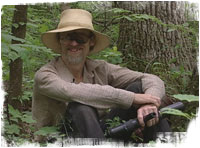
http://www.highplainsfilms.org/fp_naturalist.html
Kent
Bonar, who has been called the "John Muir of the Ozarks," is one
of America's great naturalists. Living without modern amenities
in the tradition of Thoreau, Leopold and Muir, Bonar has spent
his life observing and recording the natural history of the Missouri
and Arkansas Ozarks. The Naturalist documents the work and philosophies
of this extraordinary modern-day woodsman.
"The
film unfolds like a long walk through the woods, to show the remarkable
depth of this strange man's knowledge, and his obsession with
living things, from the birds that he calls up, to the tiny insects
and the mosses beneath the log he sits on to rest at the end of
the day. The Naturalist is the story of a man, but its larger
story is that of that rare creature, the inhabitant, intimate
with all that is around it, deeply entrenched, thoroughly dangerous
to modern notions of carelessness and frenzied mobility." Read
full review from the Mountain Gazette
|
|
North
on Evers, James Benning
1991, 16mm, color/so, 87m
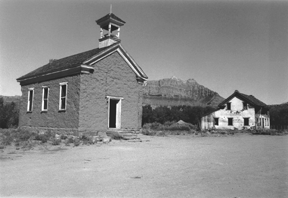
"...
NORTH ON EVERS charts the cross country ride by master framer
of landscapes and is subtitled in handwritten text that moves
across the frame. Benning overturns the notion of an easily consumable
product at the outset, as he forces the viewer to take in all
the sounds and images .... What finally emerges is an extremely
evocative picture of what's happened and is happening in this
country from someone who would clearly like to feel patriotic
today but finds patriotism very difficult. I would venture that
Benning's filmmaking is directly connected to the sense of overload:
he forces us to take in both the shots and the subtitles, the
past and the present, the sounds and the images. This is a country
defined by such overstimulation and excess, and one of the best
things about Benning's narrative scrapbook is that it never allows
us to imagine that either one of the texts is sufficient to encompass
his subject's complexity. To make this film Benning had to make
the same trip twice. To watch it once is to be distracted, but
in an evocative and resonant manner - to be drawn away from Benning's
travels and alienations and reminded of one's own." - Jonathan
Rosenbaum, Chicago Reader
|
|
Papapapa,
Alex Rivera
1995, 28:00

http://www.vdb.org/smackn.acgi$tapedetail?PAPAPAPA
http://www.thirteen.org/reelnewyork2/i-rivera.html
http://www.alexrivera.com/
http://www.alexrivera.com/PAGES/TRANSCRIPTS/papapapa.html
http://www.invisibleamerica.com/papapapa.shtml
An
experimental video about immigration. Looking at the potato (which
was first cultivated in Peru) Papapap† paints a picture
of a vegetable that has traveled and been transformed-following
the migrating potato North where it becomes the potato chip, the
couch potato, and the french fry. Papapap† simultaneously
follows another Peruvian in motion, the artist's father, Augusto
Rivera. The stories of the two immigrants, the potato and Papa
Rivera, converge as Augusto becomes a Peruvian couch potato, sitting
on an American sofa, eating potato chips and watching Spanish
language television.
|
|
Patu,
Merata Mita
1983, 110:00, 16mm

http://media.newzealand.com/index.cfm/purenz_page/5E4AC01C-5DAB-46DB-B8D1-BCCDFEE907F0.html
http://www.filmarchive.org.nz/archive_presents/1981/shootingback.html
|
|
Performing
the Border, Ursula Biemann
1999, 42:00

http://www.scdff.org/programs/oct_3/index.html
http://beenthere.bbooksz.de/
An
experimental video essay set in the Mexican-U.S. border town of
Ciudad Juarez, where U.S. multinational corporations assemble
electronic and digital equipment just across from El Paso, Texas.
This imaginative work investigates the growing feminization of
the global economy and its impact on Mexican women living and
working in the area. Candid interviews with Mexican women factory
and sex workers, as well as activists and journalists, are combined
with scripted voice-over analysis, screen text, scenes and sounds
recorded on site, and found footage to give new insights into
the gendered conditions of the high-tech industry at its low-wage
end.
|
|
Personal
Belongings, Steve Bognar
http://www.bigbeef.com/vidbeef.htm
"One
of the best of the underground films currently making the festival
circuit." - Amy Taubin, Village Voice
Personal
Belongings debuted at the 1996 Sundance Film Festival
Bognar's
work chronicles the profound displacement of Steven's immigrant
dad, Bela Bognar. The film is a home movie gone awry, a funny
and painful backyard epic about tumultuous change in one family's
life.
In
1956, young Bela Bognar took up a rifle against Soviet tanks in
his hometown Budapest. He fought alongside thousands of other
women and men. But their revolt failed. With no time to spare,
Bela fled Hungary, walking across the border with only the things
he could carry.
Decades
later, Bela finds himself a middle class American, married, with
two kids, a ranch home and an increasing sense he made the wrong
decision. Unflinchingly told by his confused, concerned son, Bela's
story is at once humorous, heartbreaking and all too relevant
to the present changes in Eastern Europe.
Steven
Bognar spent eight years making his first film, PERSONAL BELONGINGS.
An intimate documentary about his father, the film debuted at
the 1996 Sundance Film Festival. PERSONAL BELONGINGS went on to
play at South by Southwest , the inaugural Gen Art Film Festival,
and to air nationally on the PBS documentary series P.O.V. The
film won the Audience Award for best film at the 1996 Atlanta
Film and Video Festival, a Golden Gate Award at the San Francisco
International Film Festival, Best First Film at the Ann Arbor
Film Festival, and has aired on national television in France,
Germany, Russia, Australia, Poland, Hungary, Finland, Taiwan,
Quebec and Estonia. Bognar has written for indieWIRE and The Independent.
|
|
(The)
Plow that Broke the Plains, Pare Lorentz
1936, 49:00

http://xroads.virginia.edu/~1930s/FILM/lorentz/front.html
http://xroads.virginia.edu/~1930s/FILM/lorentz/plow.html
Filmmaker/critic
Pare Lorentz was the creative force behind the landmark documentary
The Plow That Broke the Plains. The project was underwritten by
the United States Resettlement Administration, a New Deal organization.
Lorentz' film accomplished visually what President Roosevelt's
radio speeches had been doing orally: serving as a wake-up call
to those Americans unaware of the deprivations of the "Dust Bowl."
The film details the ecological causes for the natural disasters
befalling farmers in Oklahoma and Texas. It then illustrates in
up-close-and-personal fashion the devastating effect those disasters
had on the farmers and their families, who were already reeling
from the Depression. Lorentz concludes his film on an upbeat note,
showing the efforts made by the Resettlement Administration to
improve conditions for the unfortunate farmers, and to make certain
that environmental reforms are put into effect to prevent another
Dust Bowl. The Plow That Broke the Plains was followed by the
Tennessee Valley Authority-sanctioned The River, likewise assembled
by Lorentz. ~ Hal Erickson, All Movie Guide
|
a
- f | g - p | q - z
|























